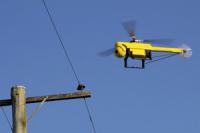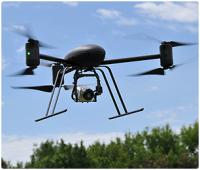-
Making production of high explosives cheaper, safer
Scientists from the U.S. Army Research Laboratory (ARL) and the Lawrence Livermore National Laboratory found a solution to a significant challenge in making high-energy explosives. They safely improved the overall chemical yield derived from diaminoglyoxime, known as DAG, and significantly increased the amount of material made per reaction.
-
-
Blast, impact simulations help researchers better understand injuries and body armor

Researchers at Sandia Lab have studied the mechanisms behind traumatic brain injury for about a decade. Their traumatic injury modeling and simulation project began with a head-and-neck representation, and now they’ve created a high-fidelity, digital model of a man from the waist up to study the minute mechanisms behind trauma. The specialized computer modeling and simulation methods help researchers better understand how blasts on a battlefield could lead to traumatic brain injury and injuries to vital organs, like the heart and lungs.
-
-
Drones learn to navigate autonomously by imitating cars, bicycles

Researchers have developed an algorithm called DroNet which allows drones to fly completely by themselves through the streets of a city and in indoor environments. The algorithm had to learn traffic rules and adapt training examples from cyclists and car drivers.
-
-
Using fungi for self-healing concrete to fix bridges
America’s crumbling infrastructure has been a topic of ongoing discussion in political debates and campaign rallies. The problem of aging bridges and increasingly dangerous roads is one that has been well documented and there seems to be a consensus from both democrats and republicans that something must be done. Researchers propose using fungi for self-healing concrete — a low-cost, pollution-free, and sustainable approach to shoring up U.S. infrastructure.
-
-
Thorium reactors could dispose of large amounts of weapons-grade plutonium
Scientists are developing a technology enabling the construction of high-temperature, gas-cool, low-power reactors with thorium fuel. The scientists propose to burn weapons-grade plutonium in these units, converting it into power and thermal energy. Thermal energy generated at thorium reactors may be used in hydrogen industrial production. The technology also makes it possible to desalinate water.
-
-
Checking chemical detectors’ sensitivity to chemicals

The Joint Chemical Agent Detector (JCAD) has become an important defense tool on battlefields and in war-torn cities over the last few years. About the size and shape of a VHS tape or a hardcover bestselling novel, JCADs sound an alarm and begin to light up if nerve agents such as sarin or blister agents such as mustard gas are present. The detectors are already designed to withstand intense environments and repeated use. But when the Department of Defense wanted a way to check the devices’ sensitivity to chemicals over time, a measurement team at the National Institute of Standards and Technology (NIST) was called in to provide a cost-effective solution.
-
-
Interconnected technological risks: Responding to disruptions of cyber-physical systems
When infectious diseases strike, the World Health Organization acts swiftly, coordinating with the U.S. Centers for Disease Control and Prevention and its foreign counterparts to contain the threat. But there is no equivalent international organization similarly dedicated to identifying and mitigating a cyberattack. The World Economic Forum (WEF), however, is bringing together infrastructure and technology developers, insurers and government officials from across the globe to develop strategies for responding to interconnected technological risks, including those that can cascade when hackers disrupt cyber-physical systems.
-
-
Distant-scanning crowds for potential threats
Everyone wants to be safe and secure, but can you imagine if you had to go through a security screening at the metro station like there is at the airport? What if there were a way to safely scan crowds for potential threat items in places like metro and train stations without security officials coming into direct contact with the public and while maintaining individual privacy?
-
-
Call for proposals on advanced first responder technologies
Applications are now being accepted for the NextGen First Responder Technologies solicitation, an opportunity for a maximum conditional grant of up to $1 million, jointly funded by the DHS S&T and the Israel Ministry of Public Security (MOPS). the NextGen First Responder Technologies program is looking for innovations in fields such as protective clothing, wearable technology and situational awareness.
-
-
U.K. gov. launches £3M competition for innovative airport bomb-detection tech
Two U.K. government ministries — the Home Office and Department for Transport—have launched a Dragons’ Den-style investment prize, hoping to find innovative ways to detect bombs in laptops, phones, and cameras carried by passengers on board. The government has announced a £3 million competition in an effort to attract scientists and inventors to help the security services and the airline industry keep up with the nefarious ingenuity of terrorists.
-
-
AI used to limit collision-prone roadways
Could a traffic agency identify a potentially dangerous road intersection without first witnessing a collision? Researchers are attempting to answer that question as they near completion on a two-year proof-of-concept study to develop an image-based system for monitoring and assessing the safety of intersections.
-
-
Developing a secure, un-hackable net for quantum devices
To date, communicating via quantum networks has only been possible between two devices of known provenance that have been built securely. With the EU and the United Kingdom committing €1 billion and £270 million, respectively, into funding quantum technology research, a race is on to develop the first truly secure, large-scale network between cities that works for any quantum device.
-
-
Quantum speed limit may put brakes on quantum computers
Over the past five decades, standard computer processors have gotten increasingly faster. In recent years, however, the limits to that technology have become clear: Chip components can only get so small, and be packed only so closely together, before they overlap or short-circuit. If companies are to continue building ever-faster computers, something will need to change. One key hope for the future of increasingly fast computing is my own field, quantum physics. Quantum computers are expected to be much faster than anything the information age has developed so far. But my recent research has revealed that quantum computers will have limits of their own – and has suggested ways to figure out what those limits are.
-
-
Balloon-borne infrasound sensor array detects explosions
Infrasound is sound of very low frequencies, below 20 hertz, which is lower than humans can hear. African elephants produce infrasound for long-distance communication at around 15 hertz. For comparison, a bumblebee’s buzz is typically 150 hertz and humans hear in the range of 20 to 20,000 hertz. Infrasound is important because it’s one of the verification technologies the U.S. and the international community use to monitor explosions, including those caused by nuclear tests. Traditionally, infrasound is detected by ground-based sensor arrays, which don’t cover the open ocean and can be muddled by other noises, such as the wind. Sandia Lab scientists is using sheets of plastic, packing tape, some string, a little charcoal dust, and a white shoebox-size box to build a solar-powered hot air balloon for detecting infrasound.
-
-
Detect illicit drone video filming

Researchers have demonstrated the first technique to detect a drone camera illicitly capturing video. Their study addresses increasing concerns about the proliferation of drone use for personal and business applications and how it is impinging on privacy and safety.
-
More headlines
The long view
Risk Assessment with Machine Learning
Researchers utilize geological survey data and machine learning algorithms for accurately predicting liquefaction risk in earthquake-prone areas.
Bookshelf: Smartphones Shape War in Hyperconnected World
The smartphone is helping to shape the conduct and representation of contemporary war. A new book argues that as an operative device, the smartphone is now “being used as a central weapon of war.”
New Approach Detects Adversarial Attacks in Multimodal AI Systems
New vulnerabilities have emerged with the rapid advancement and adoption of multimodal foundational AI models, significantly expanding the potential for cybersecurity attacks. Topological signatures key to revealing attacks, identifying origins of threats.
